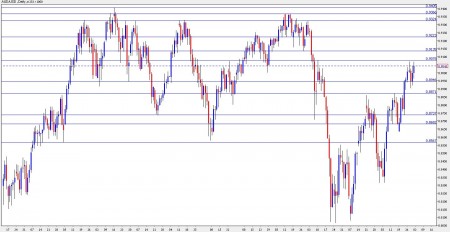A very busy week expects Aussie traders, with the rate decision standing in the limelight. Here’s an outlook for the 13 events that will rock the Aussie, and an updated technical analysis for AUD/USD.
AUD/USD daily chart with support and resistance lines on it. Click to enlarge:
The quarterly release of CPI was weak in the past week. This hurt the Aussie, as this convinced everybody that there will be no rate hike. Let’s start:
- AIG Manufacturing Index: Published on Sunday at 23:30 GMT. The Australian Industry Group published its first PMI-like index very early in the week. According to this survey of 200 manufacturers, activity slowed down in the past month from 56.3 to 52.9 points. Another drop is predicted this time, but the score will probably remain above 50 – meaning economic expansion.
- MI Inflation Gauge: Published on Monday at 00: 30 GMT. The Melbourne Institute publishes this unofficial CPI figure once a month, filling the gap for the government, which releases the consumer price index only once a quarter. Inflation slowed down to 0.3% last month and will probably be the same this time, or even lower. The official CPI was also weaker than predicted.
- HIA New Home Sales: Published on Monday. The Housing Industry Association showed a drop of 6.4% in new home sales, after a rise in a similar scale (6.2%). This volatile index will probably drop once again – the result of the rate hikes, but the scale will probably be smaller.
- Commodity Prices: Published on Monday at 6:30 GMT. This release comes a few hours after New Zealand’s similar release. Nevertheless, it always rocks the Aussie. The year over year change stood on about +43% in the past two months. A similar number is expected now.
- ANZ Job Advertisements: Published on Tuesday at 1:30 GMT. This unofficial employment gauge serves as warm up for the official job figures due 9 days later. The amount of jobs advertised in the media made a nice rise of 2.7%, going hand in hand with the improvement seen in the official figures. Another rise is expected this time. Note that two more important market-moving figure are released at the same time. They’re listed below.
- Building Approvals: Published on Tuesday at 1:30 GMT. After two sharp drops seen in previous months, the number of approvals is expected to recover with a rise of 2.1%. Note that this indicator tends to be very volatile, yet highly regarded.
- Retail Sales: Published on Tuesday at 1:30 GMT. This important consumer figure is of high importance. Three months of small rises will probably be followed by a fourth one – the volume of sales will probably rise by 0.4%, double last month’s rise.
- Rate decision: Published on Tuesday at 4:30 GMT. Three hours after the influx of three major indicators – the most important event occurs. The last rate hike from Glenn Stevens came in May, when he hiked the Cash Rate from 4.25% to 4.50%. Since then, it remained unchanged. Also now, especially after the weak CPI, the RBA doesn’t fear inflation, and will probably leave the rate unchanged. The Aussie will shake on the accompanying RBA Rate Statement, which will provide explanations for the decision.
- AIG Services Index: Published on Tuesday at 23:30 GMT. According to AIG, the services sector is contracting. The survey of 200 companies scored 48.8 points last month. A score under 50, as seen also in the previous month, means that the sector is squeezing. It’s now expected to rise and top the 50 point mark.
- Trade Balance: Published on Wednesday at 1:30 GMT. Australia enjoys a surplus in its trade balance in the past two months. Last month’s surplus, 1.65 billion, exceeded expectations by a three-fold. Another rise, to 1.81 billion, is expected now.
- HPI: Published on Wednesday at 1:30 GMT. This official house price index lags other indicators, but is of high importance due to the fact that it’s released only once per quarter. After a full year of strong rises (between 4.2% to 5.1%), a smaller rise will probably be seen this time – 2.2%.
- AIG Construction Index: Published on Thursday at 23:30 GMT. The last indicator from AIG unexpectedly fell below 50 points last month, triggering worries about this sector as well. It’s now expected to bounce back from 46.4 to above 50.
- RBA Monetary Policy Statement: Published on Friday at 1:30 GMT. This statement from the central bank continues the rate statement. It not only explains the policy, but also consists of forecasts for the upcoming months. Hints about monetary policy can also be seen here. The Aussie usually rocks on this release.
AUD/USD Technical Analysis
The Aussie rose to the area of 0.9080 at the beginning of the week, but it then fell sharply under 0.8950. A second rise also stopped at around 0.9080, making it a new resistance line (didn’t appear last week). The Aussie finally closed at 0.9043, above the psychological 0.90 line.
AUD/USD is bound in the area that it traded in the past week – between 0.8950, which was also a support line in November, and 0.9080 – the double-top in the past week.
Looking down, the next line of support is 0.8870 that capped the pair twice in June and July. After this line was broken to the upside, AUD/USD didn’t get close to it, making it a strong line.
Below, 0.8735 was the low point in December and also a line of support recently. It’s followed by 0.8660, also a minor support line in recent months, and then by 0.8567, which provided support many times in the past year, and also served as a resistance line in May.
Looking up above 0.9080, the next resistance line is quite close – 0.9135. This was a support line when the Aussie was trading higher. Above, 0.9220 had a similar role, and it works as resistance as well.
Even higher, 0.9327 held the pair 5 times in the past year, and provides strong resistance. The next lines are close – 0.9366 was a peak in April, and 0.9405 is the highest level in 2009.
I remain bullish on the Aussie
Despite the weak CPI, the Australian economy is doing great. With strong employment, AUD/USD has more room to rise.
Further reading:
- For a broad view of all the week’s major events worldwide, read the USD outlook.
- For EUR/USD, check out the Euro/Dollar Forecast.
- For GBP/USD (cable), look into the British Pound forecast.
- For the New Zealand dollar (kiwi), read the NZD/USD forecast.
- For USD/CAD (loonie), check out the Canadian dollar forecast.
Want to see what other traders are doing in real accounts? Check out Currensee. It’s free..

